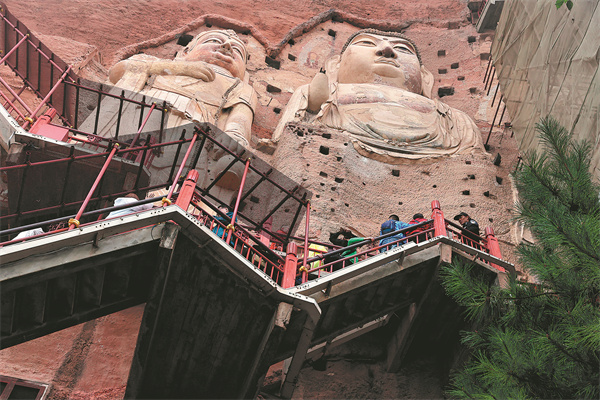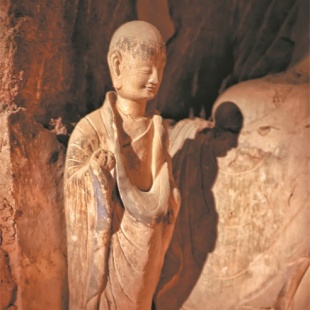Protecting mountains of relics


Technology and devoted workers help extend life of ancient cave temple complex, Wang Ru reports in Tianshui, Gansu province.
From the memories of Mu Changyou, a 59-year-old resident of Maiji village in Tianshui, Gansu province, he would recall often looking up to see the giant Maiji (wheat stack) Mountain in his family's courtyard. Similar to a wheat stack, the mountain is home to many ancient Buddhist caves carved into the cliffside, collectively known as the Maijishan Grottoes.
In 1985, he received an opportunity to work on the mountain he had grown up seeing every day, becoming a restorer of the cultural relics in the caves. From an apprentice cleaning caves and organizing tools to a master training students, he has devoted four decades of his life to accompanying and extending the lives of his old friends.
Mu is one of the many professionals who protect the Maijishan Grottoes, a cave temple complex known as "a gallery of Eastern statues", due to its particularly complete chronological sequence of its statues, built by pious ancient Chinese people from the Sixteen Kingdoms period (304-439) to the Qing Dynasty (1644-1911).
As part of the UNESCO World Heritage site, "Silk Roads: the Routes Network of Chang'an-Tianshan Corridor", Maijishan Grottoes have 221 caves, 161 of which still house Buddhist statues or murals. However, time has taken its toll on this old site, and heritage protectors have explored various ways to protect it.
Over the past eight decades, from establishing files and consolidating dangerous rocks to the successful application for World Heritage status, generations of heritage protectors have contributed great efforts to its protection, says Yue Yongqiang, deputy director of the Art Institute of Maijishan Cave-Temple Complex, which oversees the site.
For example, unlike the common impression that Northwest China's Gansu province is an arid region, Tianshui, located in the southeastern area of the province, receives abundant rainfall, which causes water damage to the caves.
"Compared to many other important cave temples in China, which have stone statues, Maijishan Grottoes have clay statues with wooden frames or stone fetuses, just like those in Dunhuang, Gansu. In such a humid environment, the statues and murals here are more difficult to protect than in Dunhuang," says Hu Junjian, deputy director of theprotection and research office of the institute.
Dunhuang is home to the Mogao Caves, a UNESCO World Heritage site on the ancient Silk Road, with more than 700 Buddhist caves that feature exquisite murals and statues from the 4th to the 14th centuries.
Water damage is a major challenge for the Maijishan caves. In 2018, after two weeks of continuous rainfall, cave 127 reached humidity of 100 percent in the following three months, leading to an outbreak of microorganisms. Protectors then found a large area on the northern side of the cave, paved with a white flocculent mass.
Researchers sampled the substance and took it to a laboratory to identify it. They conducted experiments to select the proper methods of cleaning the flocs and applied a sterilizing agent, which was effective and environmentally friendly, in the cave to remove the mass. In 2019, their approach succeeded, removing the microorganisms and impeding their continued spread in the cave.
Xu Bokai, another deputy director of the institute's protection and research office, says they began studying the water seepage paths inside the mountain body to take specific steps to block the cracks.





































